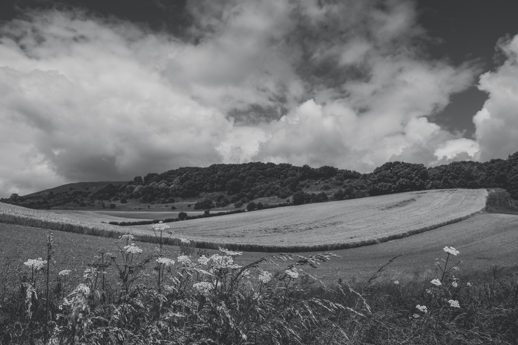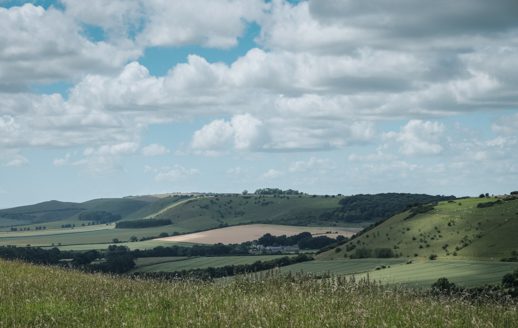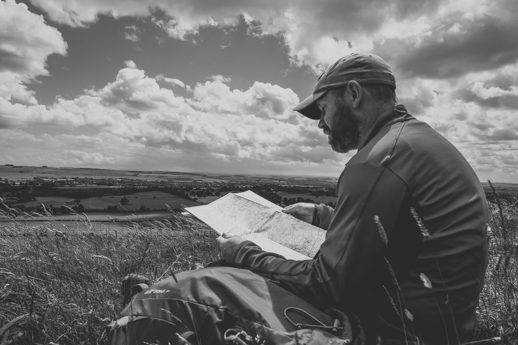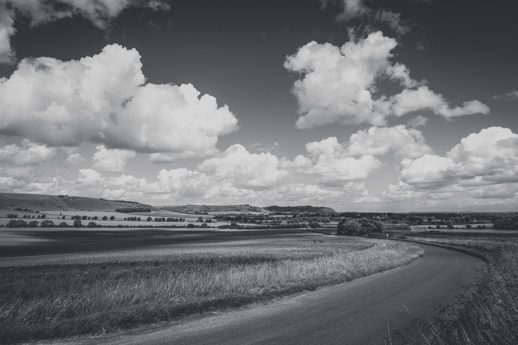
Words and pictures: Malcolm Anderson
I leave Knapp Hill and head off along the abrupt edged chalk ridge past Golden Ball Hill. The expanse of the Pewsey Vale spreads out beneath me, vacillating, now-green now-gold, as the morning light shifts on the breeze.
Walking up here along the ridge, surrounded by the grass-covered remnants of ancient hands you feel the history of Britain under every footstep and with every breath. Long barrows, causewayed enclosures and tumuli abound; the very life-blood of our ancestors seems spread across the sweep of long-grazed greensward. The fields themselves, if you look from the air, show signs of Celtic farming with their almost square fields, much broader than the open field strips that followed. I cannot walk through this history without being filled with wonder at the physical remnants left behind by previous peoples. I wonder if in a thousand years, someone will walk across the south of England and marvel at the out of town shopping villages and wonder at the people who populated this land in the late 21st Century.
Unconcerned by my musings however, the landscape endures with a quietly understated gentility. Whilst not having the hard edged splendour of a mountain ridge, nor the intangible ever-changing pull of the sea, this landscape is breathtaking in its own way. A picture postcard of pastoral England; the great open-faced wall of chalk sweeping up like a standing wave, up and away from the lower lying greensand of the vale with its roads, woodlands, hedges and village spires. Approaching Gopher Wood I step off the chalk and descend down through the pages of a geology textbook and follow the deep ash shaded curve of an old drovers track off the downs.

I meet Roz between Huish and Oare and quickly consulting the map we turn to head back up onto the chalk but before we can set off, a shepherd, who needs help extracting a young sheep from a stretch of hedge where she’s got stuck, approaches us. As repayment for our help he takes us across the Keswick’s land missing out a part of the footpath. It’s only later that I realise that by helping with the sheep and then skipping a stretch of footpath we missed the view of the heart-shaped wood of Oare, which is located up on Huish Hill. Planted in 1999 as a memorial to her two brothers by Lady Keswick, these thousand hawthorn trees form a perfect heart shape, which flower pink in the spring. Personally if I’ve made sufficient impact on anyone on this planet that when I shuffle off this mortal coil they plant a single tree, I’d be delighted.
We rejoin the footpath at Huish in the fabulously landscaped grounds of the old house and head along the old drove, up onto the chalk. As we pass into the undersea light of the ash canopy it starts to rain with a sudden urgency. The percussion of drops on leaves sounds for all the world like escaping gas and the air around us becomes thick and moist, heavy with the distinctive petrichor of a summer day.
At the top of the track we shelter under a beautiful old sycamore that stands proud in the confluence of five footpaths that radiate out from its space like the spokes on a wheel. Our intention is to head north from here towards the Wansdyke and then head East towards West Woods but after about 200m we are turned about. The path is so cut up by four wheel drives and horseshoes that it is almost impossible to walk along without swimming in mud so we retreat to the Sycamore and take the eastern footpath out onto the open downland.
The Wansdyke, (Wōden’s Dyke to give it it’s Saxon name) for those who haven’t set foot upon it, is an ancient embankment and ditch that runs from Wiltshire to Bristol although only sections of it are still visible on the surface. There is still enough mystery about the Wansdyke and why it existed that it still pulls me to explore it in greater detail, but that’s a whole different story, and best saved for another time. For now I must heed the call of the river.
The footpath snakes along between two waist high earthworks, their long grassy sides dotted with flashes of colour from half glimpsed wildflowers. A herd of young bullocks have taken up residence in one section of the path and as they suddenly decide we’re interesting enough to investigate I slip Mungo off the lead and we bolt for the gate.

Beyond the gate thick beech hedges bearing the scars of too many years under a tractor’s flail flank either side of the rough, wheel flattened track. The air feels uncomfortably still here after the wide-open spaces of the downs, too silent. Stuck in the moment between inhale and exhale. A pregnant pause before the tentative whispering of some difficult to voice secret. We walk on hand-in-hand through the stillness and the sunlight flashes urgently through the foliage, communicating vital messages in a blinking semaphore that frustratingly fades before I can grasp their meaning.
Turns out the world may have been telling us to turn back.
It’s a few minutes before we notice the first horsefly. Five minutes in and they’re becoming a bit of a pest, on our clothes and any patch of bare skin. Ten minutes in and we are being bombarded by the biting little fuckers. Our pace is accelerating and we are flapping our arms like we’re trying to take off from a short runway. I’ve got a long sleeved top on and am still being bitten through my clothes. Roz has short sleeves on and is being eaten alive. I’ve never seen so many horseflies concentrated in one area, the air is thick with them, and they just go on and on. For half an hour we march on, too-fast for the terrain, swatting at arms, necks and legs as we go. The thoughts of a pleasant walk have disappeared and instead we are driven to focusing on just getting through. It is with a massive sigh of relief that we eventually emerge back onto the chalk above Clench Common.
We skirt the earthworks of Martinsell camp and are both somewhat underwhelmed. Perhaps I’m spoiled, having grown up amongst the hillforts of West Dorset but approaching from the northeast there is little on the ground to scream ‘history’. Its prehistoric 32 acres are buried under yellow Rape, its single ditch and embankment hidden under encroaching gorse and brambles. In 1819 Colt Hoare describes Martin’s Hill in detail in his Ancient Wiltshire as being more impressive for its location than its earthworks:
“This hill, in its formation, presents a peculiarity rather contrary to the usual system of nature, by rising in height towards the east, where a bold and tremendous precipice of smooth turf shelves down from the summit to the base of the hill. This eminence is more remarkable for the rich and extensive prospect which it affords than for the plan of its entrenchments, which consists of a single vallum and fosse. Not having discovered by digging any certain marks of ancient populations within its area, I am inclined to think that it may be considered as an asylum to which the Britons, who were very numerous in its environs, sent their families and herds in times of danger: the single vallum and ditch prove its British origin, and the great extent of its area seems to warrant this conjecture.”
It is definitely the aspect of the place that makes us pause as we get towards the Southern edge and look out once more out across the lush greens of the Pewsey Vale. It’s difficult not to just stand and stare, but our destination is only another quarter of a mile away, so we push on.
Giant’s Grave is a promontory fort on top of a sharp-sided finger of chalk that juts out into the greensand valley southwest of Martinsell Hill. It hosts the remains of a number of pit dwellings and a dew pond, protected by a double earth bank to the east. As we sit here and ponder what to do next over a drink and a cookie it strikes me that the most notable part of the walk so far, apart from the little bitey-buggers, has been the conspicuous absence of water. It’s the ancient dew pond in front of me that’s actually brought it home. Down in the valley, the farms I can see all have small ponds in their fields, but up here on the chalk access to water must have been a real issue, or at least the lack of it.

As this whole journey is supposed to be about the river I can’t help but get the feeling that it’s time to step off the chalk, despite how impressive it is up here. It’s time to get down into the Vale and look for the source of the river properly as up at its top end the river Avon isn’t a chalkstream at all. The river rises in the greensand, or at least it mostly does, but more on that soon. For now I’m going to just sit here a while longer and enjoy the view.
Malcolm Anderson on Caught by the River/on Twitter